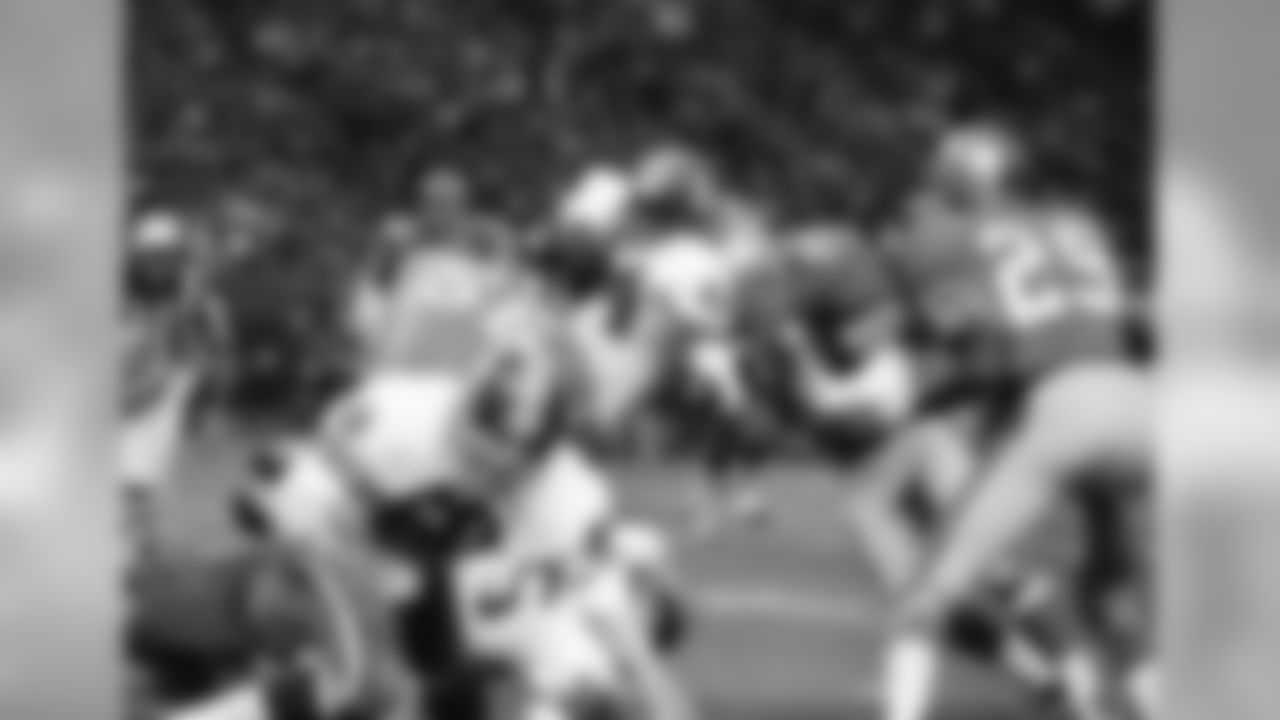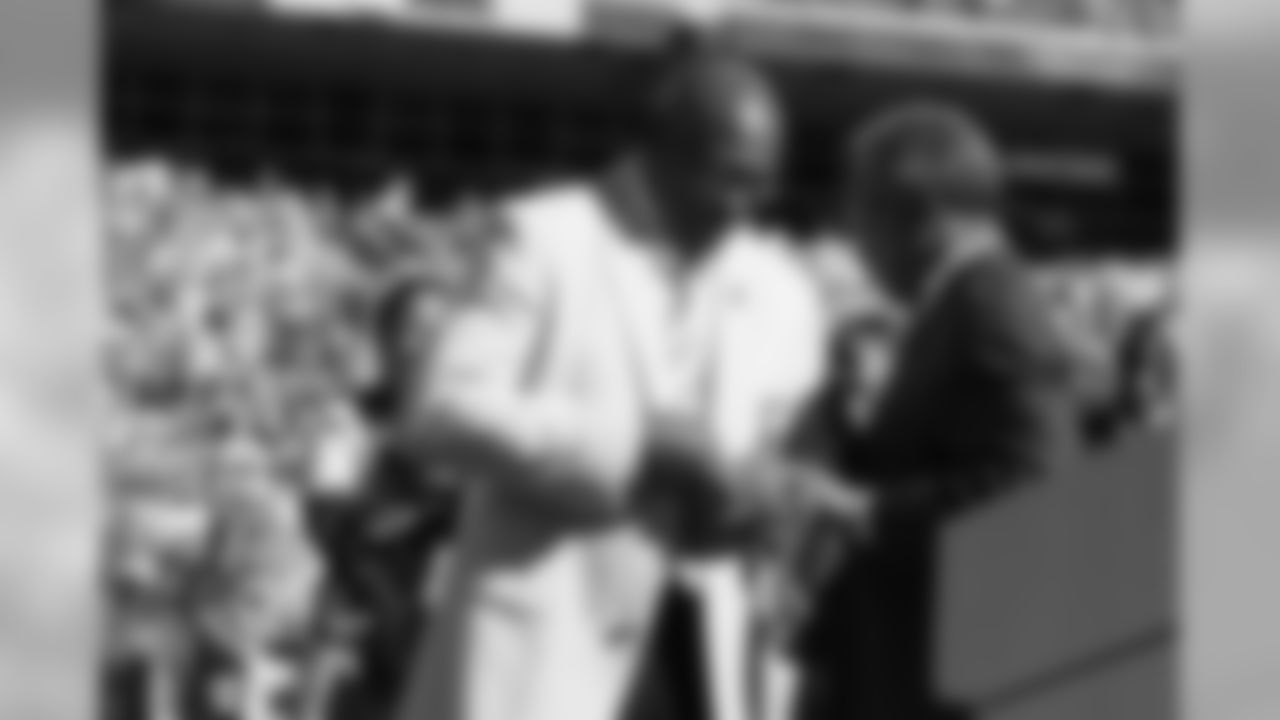The greatest celebration of the Fourth of July is that of the United States of America, with food and fireworks (when allowed), a festival for the entire nation.
But there are other celebrations in conjunction with the Fourth of July, and the most prominent to Denver Broncos fans is that it is the birthday of Floyd Little.
A Pro Football Hall of Famer and the first player chosen for the Broncos Ring of Fame, Little stands as the first great Denver player and one whose exploits are known by all in Broncos Country. Of course, his many honors in recent years rekindled his statistical greatness for everyone.
But once upon a time, before the present, there was the beginning.
Floyd Little symbolized pro football in Denver for many years, certainly for the entire period before the Broncos made the playoffs and became annual championship contenders.
So meager was the state of the Denver franchise over most of its first two decades that this author and late sports columnist Dick Connor gave Little the nickname "The Franchise," which he has justly carried to this day.
Like those of the Broncos, Little's beginnings were humble.
"Very, very difficult and very challenging," Little told me.
Like life for the Broncos, nothing came easy.
Relive Floyd Little's prolific career with the Broncos and several memorable moments as a Broncos alumnus with these rarely seen photos.

Floyd Little and his mother Lula Little, New Haven, Connecticut, have a hug for each other and a smile for the photographer after Floyd's standout performance in 51-13 stomping of Pitt by Syracuse on Oct. 30, 1965 at New York's Shea stadium. Little romped for four touchdowns, one a 95 yarder. (AP Photo)

Syracuse Orangemen's Floyd Little (44) keeps charging down the field despite efforts of Baylor's Willie Walker (83) and Paul Ortiz (30) trying to stop the hard running halfback during third quarter of their game on Sept. 12, 1966 at Baylor Stadium in Waco, Texas. Coming in to assist on the play are O.B. Goolsby (50) and Bob Purvis (18). Baylor won the non-conference game, 35-12. (AP Photo/FK)

Floyd D. Little, Syracuse halfback, holds Player of the Year award presented to him at the 12th annual dinner of the Eastern College Athlete conference in New York on Dec. 8, 1966. (AP Photo)

Halfback Floyd Little poses after becoming the first first-round draft pick to sign with the Broncos.

Floyd Little and Bo Hickey candid

Halfback Floyd Little runs downfield behind lead blocker Mike Haffner on a 66-yard touchdown run during a November 24, 1968 win (34-32) over the Buffalo Bills at Bears Stadium.

Denver Broncos halfback Floyd Little (44) is seen in action circa 1969. (Tony Tomsic via AP)

Denver Broncos halfback Floyd Little (44) circa 1969. (Tony Tomsic via AP)

Denver Broncos halfback Floyd Little (44) is seen in action circa 1969. (Tony Tomsic via AP)

FILE - In this September 1969 file photo, Denver Broncos' Floyd Little avoids the tackle of New York Jets' Steve O'Neal (20) during a football game in Denver. At left is Jets' John Dockery (43). In August 2009, a month after retiring from the car business by shuttering the dealership he'd run for 32 years, Little was finally a Pro Football Hall of Fame nominee, something he had started to suspect he'd never see in his lifetime. (AP Photo/File)

Floyd Little (44) of the Denver Broncos avoids the tackle of Jets' Steve O'Neal (20) and continues on his way to the Jets 1-yard line where he was tripped up in Denver, Colo., Sept. 22, 1969. Little returned a Jet kick for 56 yards during the second quarter to set up a Denver touchdown on the next play . Jets players in background are: John Dockery (43), Stewart Wayne (89) and Pete Perreault. The Broncos scored an upset 21-19 win over the Jets before a standing room only crowd of 51,000. (AP Photo/Bob Scott)

Halfback Floyd Little tries to turn the corner as linebackers Gordon Lambert and Ken Criter block during a September 29, 1969 win (21-19) over the New York Jets at Mile High Stadium.

Los Angeles Rams running back Jack Snow (left) snaps a souvenir picture of the Denver Broncos running back Floyd Little and Spec. 4 Charles Perea (Salida, California) during a handshaking tour at a military hospital in Saigon on Jan. 28, 1970. Perea is in the hospital recovering from wounds from a booby trap explosion during an operation in the Mekong Delta. At center is St. Louis Cardinals defensive end, Charles Walker. (AP Photo/Dang Van Phuoc)

Pfc. Stanley M. Serokal, a patient at a military hospital in Saigon, gets a hand on a a puzzle from Denver Broncos' running back Floyd Little, Jan. 28, 1970. Led by Bill Granholm of the Football Commissioner's office, Little and four other professional players are currently on a two-week tour of the war zone. The visit to the Saigon hospital marked their first full day of activities in Vietnam. (AP Photo/Dang Van Phuoc)

Denver Broncos running back Floyd Little (44) as he was headed off by Houston Oiler Olen Underwood (56) and Tom Domres (71) in the first quarter of the game in the Houston Astrodome on Nov. 29, 1970. Little tried over his right tackle and picked up three-yards as teammates Bob Young (60) and Clem Turner (35) tried to open up a hole for him. (AP Photo/EFK)

Floyd Little

Halfback Floyd Little tries to break through Chiefs tacklers during an October 4, 1970 win (26-13) over Kansas City at Mile High Stadium.

Dickie Post and Floyd Little

Denver Broncos halfback Floyd Little (44) looks on from the sideline circa 1971. (Tony Tomsic via AP)

Floyd Little (44) Denver Broncos back, plunges over the goal line from the 1-yard line for a second period touchdown in a Broncos Philadelphia Eagles pro-football game, Sunday, Oct. 31, 1971, Philadelphia, Pa. In background is Broncos quarterback Don Horn (13). Eagles trying vainly to block score are end Dick Harris (84), linebacker Tim Rossovich (82) safety Bill Bradley (28) and end Steve Zabel (89). Eagles won, 17-16. (AP Photo/Bill Ingraham)

Running back Floyd Little runs the ball downfield during a game against the Philadelphia Eagles at Mile High Stadium.

Floyd Little, running back for the Denver Broncos, 1972. Location unknown. (AP Photo)

Steve Owens of the Detroit Lions, left, Floyd Little of the Denver Broncos, center, and Willie Ellison of the Los Angeles Rams chat at the annual meeting of the 1,000 Yard Club at Appleton, Wisconsin on June 13, 1972. The three players and John Brockington of the Green Bay Packers and Larry Csonka of the Miami Dolphins gained more than 1,000 yards last season for their respective teams. (AP Photo/Paul Shane)

Denver Broncos Floyd Little (44) during a game from his 1972 season with the Denver Broncos. Floyd Little played for 9 seasons, all with the Denver Broncos, was a 5-time Pro Bowler and was inducted to the Pro Football Hall of Fame in 2010.(David Durochik via AP)

Floyd Little is honored on Floyd Little Day as the 1971 NFL Rushing champion (1133 yards) before an October 29, 1972 loss (20-27) to the Cleveland Browns at Mile High Stadium.

Former National Football League running back star Jim Brown left, chats with Mrs. A. Marie Fleming of Elmira, N.Y. and former Syracuse running back Floyd Little at a dinner, Friday, Oct. 19, 1979, New York. The dinner was held to honor former Syracuse University running back Ernie Davis. Davis, son of Mrs. A. Marie Fleming and the first black to earn the Heisman Trophy, died of leukemia in 1963 but is to be inducted into the National Football Foundation Hall of Fame on Saturday. (AP Photo/Bailey)

Floyd Little of the Denver Broncos is presented the YMCA-Brian Piccolo Award for humanitarian service at Helms Hall in Los Angeles on Nov. 20, 1973, by Dr. Robert W. Harlan, executive director of the YMCA's national council. The award, in memory of the late Chicago Bears' running back, was made to Little for his work against drug abuse among young people. (AP Photo/David F. Smith)

Floyd Little runs behind blockers during an undated game.

Denver Broncos Floyd Little (44) during a game from his 1975 season with the Denver Broncos. Floyd Little played for 9 seasons, all with the Denver Broncos, was a 5-time Pro Bowler and was inducted to the Pro Football Hall of Fame in 2010.(David Durochik via AP)

Mrs. Marie Fleming receives a plaque honoring her late son, Ernie Davis, who was inducted into the College Football Hall of Fame during half-time ceremonies at Giants Stadium on Saturday Oct. 20, 1979 as Syracuse hosted Penn State. Presenting the plaque is Vincent Draddy, President of the National Football Foundation Hall of Fame, as Floyd Little, left, who was recruited to Syracuse by Davis, and former Cleveland Browns back, Jim Brown look on. (AP Photo/Kostroun)

Floyd Little carries the ball

Floyd Little carries the ball against the Kansas City Chiefs

Bobby Anderson and Floyd Little

Floyd Little carries the ball

Floyd Little carries the ball

Floyd Little teases two youth football players

Mike Current blocks for Floyd Little

Floyd Little runs versus the Raiders

Floyd Little carries the ball against the Kansas City Chiefs

Floyd Little carries the ball against the Kansas City Chiefs

Floyd Little runs versus the Dolphins

Floyd Little take the handoff

Floyd Little trys to shake a tackler

Denver Broncos halfback Floyd Little (44) looks on from the sideline during an NFL game in this undated photo. (Tony Tomsic via AP)

Floyd Little, a running back for the Denver Broncos, autographs a program for the Rev. Robert Keating during the Connecticut Sports Writers Alliance Gold Key Award dinner in Hartford, Conn., Jan. 29, 1973, as Tom Kelley and baseball commissioner Bowie Kuhn look on . Keating, Kelley and Little were the recipients of the Alliance's Gold Key awards and Kuhn was the main speaker at the dinner. From left: Kelley, Kuhn, Little. Seated is Keating. (AP Photo/Bob Child)

Floyd Little, Pat Bowlen, and Billy Thompson met in the locker room following the Broncos victory over the Seahawks against the Seattle Seahawks at Kingdome in Seattle, WA on October 11, 1998.

09 October 2005: The Denver Broncos defeat the Washington Redskins 21-19 at Invesco Field at Mile High. Jamie Schwaberow/Rich Clarkson and Associates

Former Syracuse and Denver Broncos running back Floyd Little acknowledges the crowd during a halftime ceremony to retire the No. 44 jersey in Syracuse, N.Y., Saturday, Nov. 12, 2005. (AP Photo/Kevin Rivoli)

Former Denver Broncos running back Floyd Little celebrates with his family after being named to the 2010 Pro Football Hall of Fame class during the Hall of Fame induction announcement at the Super Bowl XLIV Media Center in Ft. Lauderdale, Fla. on Feb. 6, 2010. (AP Photos/Ben Liebenberg)

Hall of Fame running back Floyd Little announces the Denver Broncos pick during the 2010 NFL Draft at Radio City Music Hall in New York City, NY on Apr. 23, 2010. (AP Photo/Ben Liebenberg)

Floyd Little, left, Jerry Rice, center, and Emmitt Smith pose after they were elected to the Pro Football Hall of Fame on Saturday, Feb. 6, 2010 in Fort Lauderdale, Fla. (AP Photo/Wilfredo Lee)

Jerry Rice and Floyd Little share a laugh at the Pro Football Hall of Fame in Canton, Ohio on Aug. 6, 2010. (AP Photo/Ben Liebenberg)

Floyd Little, right, poses with his son, Marc, after enshrinement in the Pro Football Hall of Fame in Canton, Ohio Saturday, Aug. 7, 2010. (AP Photo/Mark Duncan)

Denver Broncos Hall of Famer Floyd Little greets Indianapolis Colts Peyton Manning during the coin toss prior to the NFL game at Invesco Field in Denver,CO.

Denver Broncos Hall of Famer Floyd Little participates in the coin toss prior to the NFL game between the Denver Broncos and the Indianapolis Colts at Invesco Field in Denver,CO.

Denver Broncos Hall of Fame running back Floyd Little's adjusts his Hall of Fame ring before addressing the fans during Floyd Little's Hall of Fame ceremony at Invesco Field in Denver,CO.

Former Denver Broncos from left to right; Tom Jackson, Floyd Little and Billy Thompson at the Mizel Institute's 2013 Community Enrichment Award night May 22, 2013 where Broncos Owner and CEO Pat Bowlen received the award in front of more than 2,000 guests, including Broncos Hall of Famers.

Denver Broncos fans celebrate at Wall Street for the United in Orange group photo in New York City on February 1, 2014.

Football great Floyd Little, stands next to a statue of himself dedicated during a ceremony on the Syracuse University campus in Syracuse, N.Y., Saturday, Nov. 14, 2015. (AP Photo/Nick Lisi)

Hall of Fame enshrinees Floyd Little and Jim Kelly attend the 2016 Pro Football Hall of Fame group photo at the Pro Football Hall of Fame in Canton, Ohio on Aug. 4, 2016. (Ben Liebenberg via AP)

Floyd Little takes a photo of the mural during the unveiling of owner Pat Bowlen's statue in the Ring of Fame Plaza at Sports Authority Field in Denver, Co. October 18, 2014.

Former Broncos Tom Jackson, Billy Thompson and Floyd Little talk as they look at Little's display case in the Pro Football Hall of Fame in Canton, Ohio. (Ben Swanson)

Former Denver Broncos and Ring of Fame members from left to right: Tom Jackson,Shannon Sharpe, Floyd Little Gary Zimmerman and John Elway watch a tribute video during the Pat Bowlen Denver Broncos Ring of Fame induction during halftime ceremonies in the NFL game between the Denver Broncos and the Green Bay Packers at Sports Authority Field in Denver, CO November 1, 2015. (Photo: © Eric Lars Bakke/ Denver Broncos)

Denver Broncos jersey retirement ceremony for Frank Tripucka, Floyd Little, John Elway and Peyton Manning prior to the NFL game between the Broncos and the Indianapolis Colts at Sports Authority Field in Denver, Colo. September 18, 2016.

Terrell Davis and Floyd Little laugh during a ceremony celebrating Davis's induction into the Pro Football Hall of Fame before the game against the Cincinnati Bengals at Sports Authority Field at Mile High in Denver, Colo., November 19, 2017. Photo by Gabriel Christus

Floyd Little hugs Steve Atwater at the Pro Football Hall of Fame's Merlin Olsen Luncheon in Atlanta on February 1, 2019.

Floyd Little during the Pro Football Hall of Fame group photo in Canton, Ohio, August 2, 2019. Photo by Gabriel Christus

Former Denver Broncos Floyd Little announces the teams pick during the second round of the 2017 NFL Draft on Friday, April 28, 2017 in Philadelphia. (Perry Knotts via AP)

Champ Bailey and Floyd Little during the Pro Football Hall of Fame Game against the Atlanta Falcons in Canton, Ohio, July 20190721, 2019. Photo by Gabriel Christus

Floyd Little talks with a fan before the Broncos' game against the Tennessee Titans at Empower Field at Mile High on October 13, 2019. (Photo by Ben Swanson)

Floyd Little and Rick Upchurch before the Broncos' game against the Tennessee Titans at Empower Field at Mile High on October 13, 2019. (Photo by Ben Swanson)

Floyd Little during the Broncos Top 100 Ceremony at Empower Field at Mile High in Denver, Colorado, October 11, 2019. Photo by Gabriel Christus

Floyd Little and Peyton Manning during player introductions prior to kickoff of the NFL game between the Denver Broncos and the Tennessee Titans , Sunday, Oct.13, 2019 in Denver. (Photo: © Eric Lars Bakke}

Floyd Little holds out his Pro Football Hall of Fame ring in the tunnel during player introductions for the ceremony recognizing the Broncos Top 100 Team before the Broncos' game against the Tennessee Titans at Empower Field at Mile High on October 13, 2019. (Photo by Ben Swanson)

Floyd Little during the NFL game against the Tennessee Titans at Empower Field at Mile High in Denver, Colorado, October 13, 2019. Photo by Gabriel Christus

The Pro Football Hall of Fame bust of Floyd Little at Empower Field at Mile High in Denver, Colorado, October 11, 2019. Photo by Gabriel Christus
An accomplished high school athlete, Little felt that his academics needed refinement to compete in the classroom at the best colleges.
"I went on to a military school [Bordentown Military Institute] and learned to do the necessary things that were important in terms of discipline, integrity and character — all of those things that are intangibles," Little said.
Thanks to his efforts, Little earned a full scholarship to Syracuse, where he was given one of the ultimate honors in college football in the 1950s and '60s. Syracuse awarded him jersey number 44, the number that Jim Brown and Heisman Trophy winner Ernie Davis had worn for the Orangemen.
At a time when freshmen could not play varsity football, Little became a three-time All-American running back at Syracuse. By doing that, Little joined a select group that includes Doak Walker, who starred at Southern Methodist University in the 1940s.
In a twist of irony, it was Walker, then a personnel man for the Broncos, who scouted Little for the Broncos.
But meanwhile, back in Denver … it was early 1967 and the Broncos had just completed their seventh straight season without a winning record. The Phipps brothers, who owned the team, had hired Lou Saban, architect of back-to-back American Football League championship teams in Buffalo, to build the Broncos. This would be the first step toward a semblance of respectability, before the playoffs could even be considered.
The merger of the American and National Football Leagues had begun to take place, and while all AFL teams were to go into the NFL, a huge condition was that every franchise must have a stadium that seated at least 50,000 people.
Prior to this, the team played in a minor league baseball park, Bears Stadium, which was half made of wood for football and only seated 35,000 fans. On March 17, 1967, metropolitan Denver voters turned down a stadium bond issue to build a suitable new stadium.
So this was the situation into which Floyd Little was drafted.
The East Coast native recalled his reaction to the news of being drafted by Denver. "I was not happy. I could not believe it when I got a call from Lou Saban that they had drafted me to the Denver Broncos. I was like, 'You have got to be kidding me.'
"I could not believe it 'til I flew out to meet Lou. I was just amazed and fell in love with Denver the first day that I saw it."
And Denver fell in love with him right away, too.
The first bona fide national superstar in Broncos history, Little was coming to a team and city hungry for success and an identity in pro football.
Little would supply the cornerstone for building franchise respect by maintaining a sterling standard of play and a quality of leadership matched very few times since. His status on the team and in the community was so revered that the future Hall of Famer was the team's only captain, as selected by his peers, during his entire nine-year career.
Little's standard of excellence as a running back was such that any reasonable ranking of Broncos players would place him on the kind of list that can be counted using just one's thumbs.
Not only was Little "The Franchise" for the Broncos, but he walked door-to-door to help drum up financial support that would ultimately lead to the expansion of that ballpark to become Mile High Stadium, meeting all standards set by the NFL merger.
The civic drive to raise the funds necessary for the stadium project ended in February of 1968, and construction began on a 16,000 seat upper deck that raised capacity above 50,000 for the 1968 season. Bears Stadium was officially renamed Denver Mile High Stadium on December 14, 1968.
He retired as the seventh all-time leading rusher in NFL history, and led the NFL in total rushing yards from 1968-73. He was also first in yards from scrimmage during that six-year time frame.
Among numerous off the field honors, Little was awarded the 1974 Byron White Humanitarian Award presented by the NFL Players Association.
Now, the Broncos have been to the Super Bowl eight times and are one of just nine franchises to have won it three times or more. The team plays in one of the NFL's crown-jewel stadiums, Empower Field at Mile High.
But back in the day there was some building to do, on and off the field, and he did not shy away from the construction.
People sometimes ask me how fast Little was.
I often respond that he had great speed, especially considering that he was carrying an entire time zone on his back.
Happy Fourth of July, and happy birthday to The Franchise, Floyd Little.















